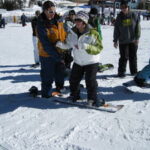How to conjugate regular verbs, in present tense, in Spanish.
In Spanish there are two different types of verbs: regular and irregular. We will take a look at irregular verbs in a later lesson. So lets focus!
First, let’s take a look three different verbs:
–escuchar (to listen)
–correr (to run)
–abrir (to open)
If you notice they have three different endings (escuchar, correr, and abrir) -ar, -er, and -ir. You will find that all regular verbs in Spanish end in one of these three endings.
Verbs in the infinitive form still have their ending (-ar, -er, or -ir) attached to them. When you’re looking a verb up in the dictionary you will find the verb in it’s infinitive form.
In Spanish you need to conjugate the verb in order for it to agree with it’s subject you need to find the steam. The steam of a verb is the verb after you take off the ending. Escuch, corr, abr would be the steams of the verbs we’ve been looking at.
The subject is the person that you’re talking about. In English the subjects are: I, you, he, she, we, they, etc. In Spanish they’re a little different, you will normally look at them like this:
yo nosotros
tú vosotros
él, ella, usted ellos, ellas, ustedes
*if you keep the subjects in this form, it is easier to conjugate until you get the hang of it
Spanish English
Yo I
Tú You (Informal)
Él He
Ella She
Usted You (Formal)
Nosotros We
Vosotros You (only used in Spain)
Ellos They (A group of men & women or only men)
Ellas They (A group of only women)
Ustedes You (Plural form)
So now you know about the verb steams and the subjects. Once you conjugate the verb its ending will need to agree with the subject. Let’s take a look at the endings, there different endings for each verb choice. The endings match with the subjects above (they are in the same location on the chart).
-ar endings -ir endings -er endings
o amos o imos o emos
as áis es ís es éis
a an e en e en
Conjugating -ar Verbs:
-First take the infinitive of the verb: escuchar
-Now find the steam of the verb: escuch
-Now you can add the subjects and corresponding endings:
yo escucho nosotros escuchamos
tú escuchas vosotros escucháis
él, (ella, usted) escucha ellos, (ellas, ustedes) escuchan
Now you have a conjugated verb! So, in order to say I listen you will use the conjugated verb: Yo escucho.
Many native speakers do not use the subject once the verbs are conjugated. Yo escucho and escucho both mean I listen.
Now lets conjugate the -er and -ir verbs, they’ll be done the same way as the -ar verb.
Conjugating -er Verbs:
-First take the infinitive of the verb: correr
-Now find the steam of the verb: corr
-Now you can add the subjects and corresponding endings:
yo corro nosotros corremos
tú corres vosotros corréis
él, (ella, usted) corre ellos, (ellas, ustedes) corren
Conjugating -ir Verbs:
-First take the infinitive of the verb: abrir
-Now find the steam of the verb: abrir
-Now you can add the subjects and corresponding endings:
yo abro nosotros abrimos
tú abres vosotros abrís
él, (ella, usted) abre ellos, (ellas, ustedes) abren
Now you know how to conjugate the three types of Spanish verbs in present tense!




